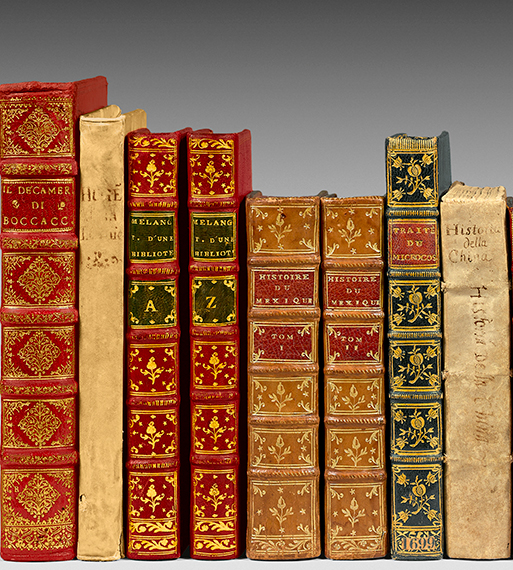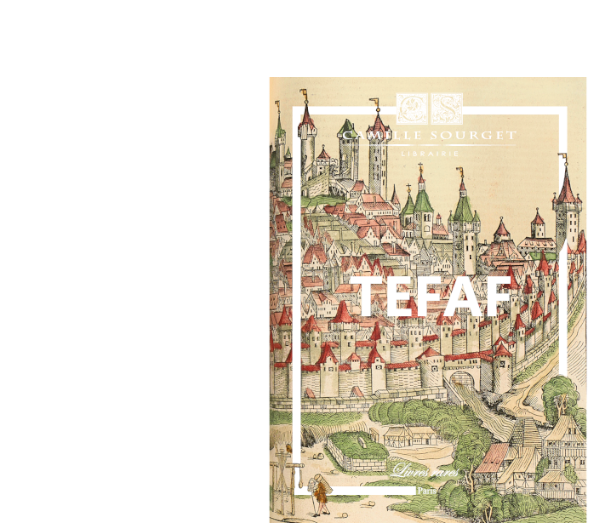Original edition 1very sought after7 (Clouzot).
Precious copy signed by the author to the uncle and aunt of his wife Julia,
Paul and Cécile Navoit.
Daudet, Alphonse. Contes du lundi.
Paris, Alphonse Lemerre, 1873.
In-12 of (4) ff., 258 pp. Bound in half hazel chagrin, spine with raised bands decorated with gilt fillets, marbled edges. Some discreet rubbing on the spine. Binding from the period.
178 x 112 mm.
Original edition of this 1very rare work by Alphonse Daudet containing 31 tales of the author’s best inspiration7 (Carteret, I, 194).
Clouzot, 81; Vicaire, III, 41; Rahir, The Amateur’s Library, 391; Talvart, IV, 16.
Carteret mentions 4 copies on China paper not reported by Talvart.
1Remarkable work by Alphonse Daudet, published in 1873 and which, without making one forget the ‘Lettres de mon moulin’, did as much for the author’s glory as all his novels. This collection includes around forty tales, most of which evoke the short and terrible war of 1870: the Invasion, the Siege of Paris, and the Commune. Nothing but things seen, so to speak. Less realistic than impressionistic, Daudet delights in small paintings. No one has been able, like him, to encapsulate in a few pages such poignant, unfortunate, or humorously ample situations. He excels at highlighting the weak side of humans. However, he refrains from judging: his taste for truth, his compassion, his fantasy forbid him any behavior of that kind. In this area, Daudet remains inimitable… These historically-based tales are truly of good kind, as was once said. Daudet seems to have written them offhand. It’s as if they wrote themselves. Naturalness, freshness, and simplicity: Daudet brings in his style the essence of Provençal storytellers. One also appreciates that to so much pathos he has added such a sense of discretion. That’s without a doubt what explains the appeal the ‘Contes’ have always had to many readers. 7. (Dictionary of Works, II, 64).
Precious copy offered by the author to the uncle and aunt of his wife Julia, bearing this autograph dedication at the beginning of the volume: 1Affectionately offered to Cécile and Paul Navoit. Alphonse Daudet.7
Cécile and Paul Navoit are actually the uncle and aunt of Julia Daudet, the author’s wife. Indeed, the mother of Julia Daudet, Léonide Allard born Navoit, had a brother, Paul Navoit, who was married to a certain Cécile.
The family of his wife Julia played a very important role in Alphonse Daudet’s career, as it was thanks to them that he discovered the region of Draveil after his marriage in 1867.
It was also at the Château de Vigneux, in the residence of Julia’s grandfather, Jacques Navoit, that Daudet wrote Le Petit Chose during the summer of 1867.
Acquired a few years after Alphonse Daudet’s marriage to Julia Allard, originally from Draveil, the house in Champrosay became Alphonse Daudet’s favorite summer retreat. Away from the Parisian hustle and bustle, this place regularly hosted Daudet’s close acquaintances and provided a conducive environment for writing his works.
Although Alphonse Daudet is native to the South, it should not be forgotten that he stayed nearly forty years in Paris and thirty years in the Val de Seine region. After his arrival in Paris in 1857, accompanied by his brother Ernest, he only took occasional trips to Provence.
The Île-de-France was a preferred vacation spot for Daudet from his marriage to Julia Allard in 1867. He discovered the Draveil region thanks to his wife, whose grandfather, Jacques Navoit, was the mayor of Vigneux and owned a chateau. The young couple stayed there just after their honeymoon, and it was in this chateau that Daudet wrote Le Petit Chose.
After the death of Julia’s grandfather, the chateau was sold and eventually demolished. However, the family, refusing to leave the region, initially rented Delacroix’s property in Champrosay during the summers of 1868, 1869, and 1870. Alphonse and Julia moved into the painter’s studio. The stay was fruitful, as Daudet created the famous Tartarin there. In 1871, the whole family moved into the ‘haute de la côte’ house, acquired by the Allard family. Daudet decided to spend six months in the home of his in-laws from October 1872 to March 1873.
From 1874, Daudet finally found success, notably due to the publication of Fromont jeune et Risler aîné. While the couple’s Parisian homes became more spacious, Daudet enjoyed staying in Champrosay from July to October. It was also during this period that he met Edmond de Goncourt. The latter became a regular visitor to the place; he even died there a year before Daudet, in 1896.
In spring 1887, Daudet finally purchased his own house in Champrosay, as cohabitation with the entire Allard family was becoming increasingly difficult. Gradually, Champrosay passed from the Allard clan to the Daudet clan.
Precious copy signed by the author of this classic of Provençal literature, preserved in its period binding.
The major original editions of Daudet with dedications are sought after.
Location of copies: only 5 in all French public institutions (Canteleu, Pau, Dijon, Bordeaux and B.n.F.).

